Iwo Jima: My Time on Iwo
"After
basic training , I was sent to school in Chanute AFB,
Illinois to the Air Force Weather School, for enlisted
service men. The courses of study lasted about six months
and then was assigned to Laughlin Air Force Base in Del
Rio, Texas.
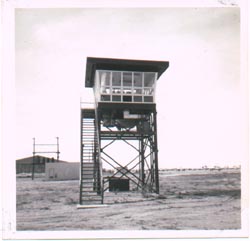
Laughlin AFB,
the 'weather tower' My first assignment in early
1963
|
Following
the assassination of President John F. Kennedy, I
following a wave of patriotic fervor, decided to
volunteer for overseas duty -- namely Viet Nam. The
position offered was that of Combat Air Traffic
Controller and after tentatively accepting the proposed
offer for training, I went on a six month regime of
physical training in preparation for school.
When I
again got back with the department handling orders, I was
matter of factly told that because of the proposed
assignment, I would need to extend my current enlistment
by 24 months. This was news to me, for at the time I had
about 13 months remaining on my current enlistment. I
turned down the assignment and was told that I would
receive orders the next morning for Viet Nam,
anyway.
This was
fine with me, for I told the Captain that in any event, I
would be home in a year anyway -- on my feet, in a wheel
chair or in an aluminum box -- but I would be home when
my enlistment ended.
The next
morning, via Teletype, I received incomplete orders for
the island of Iwo Jima instead of Viet Nam. At the time,
the name meant but little to me other than I had heard it
somewhere as being the site of a World War II battle in
the Pacific. I did not even know the location other that
'somewhere in the Pacific'.
The orders
were incomplete and I was given a 30 day leave prior to
reporting to my assignment. I was to receive additional
orders at home which were to instruct me as to where and
how I was to report for my travel overseas.
When home,
I enjoyed the freedom of being home and seeing my girl
and just enjoying being with ordinary folks and away from
the regime of military life. After two weeks at home, I
went to Alexandria (Esler, AFB) to pick up my pay and
report in to the duty officer.
I asked
about if they had received any orders for me and
discussed my current incomplete orders. No orders were
waiting for me and I was instructed to return home and
await my orders. I did this and repeated the process for
TWO months awaiting my orders.
Needless to
say, I became quite nervous and finally decided it was
time to contact the officer who had signed my original
incomplete orders.
It was the
same Captain who I had originally had the conversation
with that began this journey and he was upset to say the
least. He wanted to know where I was and why I was still
there. He also told me that he had listed me as AWOL for
a month now. This scared the hell out of me.
I was
instructed to wait by the phone and he was going to call
me right back. That was one of the longest waits I have
ever had until the phone again rang. He was on the line
and surprisingly was quite subdued in his demeanor --
almost apologetic!
He told me
that a telegram was on its way and it would serve as my
ticket for a flight out of New Orleans to San Francisco
where I would be processed to go overseas.
I caught
the flight and reported to Travis AFB where there was
large numbers of military servicemen being processed to
go over seas as well as returning from overseas.
Within a
few hours, I had complete orders and instructions to
board a flight to Japan. The flight was aboard a Boeing
707 Pan Am jetliner and we went via Anchorage, Alaska to
Honolulu, Hawaii, Midway Island and from there to Japan
landing at a base north of Tokyo. From there were bussed
to Tachikawa AFB for further processing.
Upon
arriving for further processing, I was told to report
directly to the Legal Officer. Again, I was scared out of
my mind, but did as I was told.
The Legal
Officer was a brand new, fresh 2nd Lt who greeted me with
a smile and a handshake! He sat me down at his desk and
proceeded to tell me that 'we had them by the b----' and
that I was in NO trouble with the Air Force. This was
because, while on leave with incomplete orders, I had
done everything necessary and made regular trips to the
local base, reporting in and inquiring about forthcoming
orders. They had duly noted my activities in writing. I
had done my part. The officer in charge of cutting my
orders had not and the problem was his and not mine.
I had used
some 63 days of leave while home and he further informed
me that because of the Air Force foul-up, I would not
only get paid for the 63 days leave taken BUT be granted
an ADDITIONAL 63 DAYS LEAVE on top of that!
Needless to
say, I walked out of his office on cloud
nine.
The next
day, I was on a C-54 flight out of Tachikawa for the long
flight to Iwo Jima. This was a biweekly flight which went
to the island and continued on to Okinawa. The flight was
uneventful and coming in over the island, I had my camera
and snapped a few pictures as we approached. It looked so
small and isolated.
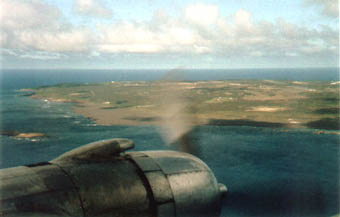
Arrival on Iwo via C-54 from
Tachikawa AFB, Japan
|
We arrived
and taxied to a location next to some quonset huts (which
turned out to be my barracks).
Upon
arrival, I went to look for the commanding officer to
report in. He was in another quonset hut a few buildings
down. He was a 2nd Lt! and in charge of all Air Force
activities on the island which turned out to have about
150 men total including about 60 U. S. Coast Guard
inhabitants on the northeast corner of the
island.
He was very
laid back and told me to go report to my detachment
commander, a sergeant who actually at that time was
flying a kite! Talk about laid back!
Sure
enough, there was a group of men flying a large handmade
kite and I went over to join them. The kite was made of
wood and brown wrapping paper and the cord used to launch
it was bailing twin and the kite was huge -- as tall as a
man!
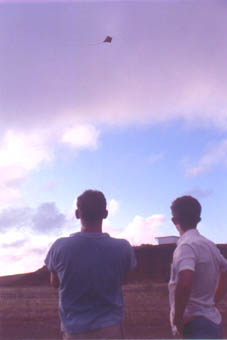 Propps and Olsen flying a
kite
Propps and Olsen flying a
kite
|
The island
had ongoing and continuous breezes coming up from the
ocean -- with the island sloping up from the beaches at a
fairly steep angle towards the interior of the
island.
Iwo
measured about a mile at it's widest point and was about
5 miles long at it's longest and shaped very much like a
pork chop. The most outstanding feature, as most folks
know, was the volcano at the narrow tip of the island --
Mt. Suribachi, of World War II fame. The view from our
base was tremendous and you could see almost completely
around the island. The water of the Pacific was the most
beautiful blue I have ever seen and the breezes coming
ashore made a sound that still to this day stays with me
the rustling of vegetation and and the feel of the breeze
on your face. Quite a wonderful site. This opinion would
eventually change as my time on Iwo Jima extended into
the upcoming months. But for now, it was a tropical
island though NOT complete with brown skinned bare
breasted beauties -- unlike Mutiny on the
Bounty!
There were
NO women on Iwo -- period!
Regular USO
tours came to the island -- about every month or so and
these women did not mingle with the common troops
there.
After my
arrival one of the first things to do was the 'island
tour of new arrivals' which was conducted by a couple of
the old hands (names escape me) and we all hopped into
the back of the base pick up truck (I believe this was
the only one assigned to the air force base) and off we
go.
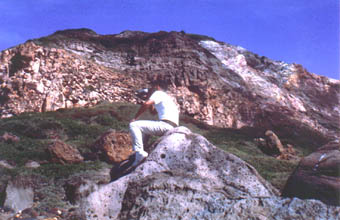
Rock formations at base of Mt.
Suribachi.
|
The tour
consisted of the first stop -- a spiraling road up Mt.
Suribachi and to view the monument where the famous flag
raising occurred and John Wayne got shot -- oops, that
was another story and maybe another movie. Anyway, off we
go to Mt. Suribachi and the view is breath taking! The
island is laid out before us and the sky is crystal clear
except for a little mist caused by the continuous
breaking waves on the beaches as well as on the coral
reefs surrounding portions of the island.
Looking
into the mouth of the volcano is something to see and is
overpowering in its scope -- huge and smoking from a few
places. We were cautioned not to descend into the mouth,
for the surface was fragile and could easily collapse
with a persons weight.
A section
of the volcano had years before been blown away by
engineers to effect lava being directed into the ocean
should the volcano erupt (it is considered an ACTIVE
volcano). The colors were vivid and not like anything I
had ever seen in my life. Everything about the volcano
and the island for that matter was all new and exciting
to the senses. What spectacular views --
everywhere!
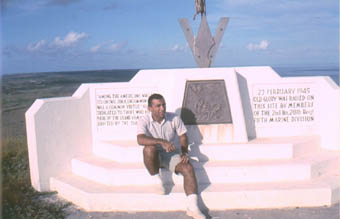
Image of me at the Marine
Monument.
|
After
visiting the top of Suribachi and having pictures taken
at the Marine monument, we headed down and continued our
tour of the island. Of course, one of the high points of
the tour was the landing beaches where the 5th Marine
Division stormed ashore on February 19, 1945 and were
decimated by the dug in defenses of the
Japanese.
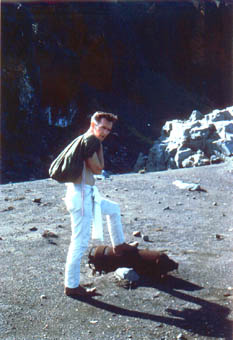
An unexploded bomb on invasion
beach
|
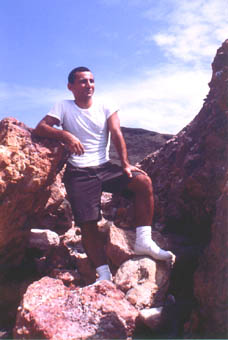
View up towards Mt.
Suribachi
from Invasion beach.
|
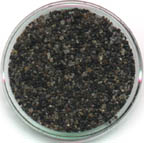
Sample of black Iwo Jima sand
from the invasion beach designated as Green-1
which was the beach closest to Mt.
Suribachi.
|
Walking the
beaches was quite an experience and the on shore breezes
were strong, the mist being whipped up by the winds and
the sights sobering. You could feel history here and you
could feel the tug of the infamous black volcanic sand
that wanted to pull you down. In some locations, you had
to struggle to walk and it was a strain -- even for a
fellow who was in good condition at the time. The beach
angled very steeply at the water line and angle up from
there to a small plateau of sorts and then leveled off
for a short distance where again, it angled fairly
steeply to the next plateau which was the main level of
the island which gradually steepened as you went
inland.
The beach
contained artifacts of the tremendous battle that
occurred on that fateful time back in 1945...and parts of
wrecked equipment were in locations that you could
inspect close up. There were also some gun emplacements
near Mt. Suibachi that were visible. There were other
emplacements that we also viewed as we worked our way
inland. A large concrete bunker was visited, and it as
expected was bullet riddled and full of debris. We also
visited a couple of machine gun nests that survived to
this day (1965) and one was most interesting -- a
Japanese Betty bomber fuselage was used with large rocks
cemented around it to protect the gun crew. Other
positions were visited and many looked like just holes in
the surface of the island until you looked closely --
peering in and seeing remnants of machine gun parts still
in position where they had been left after the attacking
Marines neutralized the position -- obviously at a very
high cost to the attackers.
Another
location we visited was a sheer rock face carving
[sandstone] that had been carved by Mr. Waldon T. Rich, a
member of the 31st SEABEE Battalion, attached to the 5th
Marine Division. Mr. Rich carved his tribute to the
fighting men of Iwo Jima while he was stationed on Iwo
during and following the battle for the island. You can
read all about the "1st Iwo Jima Memorial" and see many
images of the carving and Mr. Rich at
Waldon
T. Rich's Photo Album Page. The rock carving was of
the famous Joe Rosenthal flag raising image and was in
high relief -- quite well detailed.
Still another
visit nearby was that of a cave where many Japanese had
holed out and was eventually used by future generations
of American servicemen as a typhoon shelter until another
location was utilized.
Then the
tour took us to a location where the 5th Marine Division
Cemetery was originally located -- in the shadow of Mt.
Suribachi. There is a monument located there with the
simple words stating 'That These Men Shall Not Have Died
in Vain' which was taken from the Gettysburg address and
was also used when the cemetery was dedicated. Recently,
this web master has learned that the original monument's
plaque was produced with the guidance of Mr. Waldon T.
Rich. The plaque was constructed using spent brass shell
casings and forged into a dedication plaque. The monument
was simple and in my opinion not kept up well by the
current troops stationed on the island. It was somewhat
overgrown by the ever encroaching jungle.
The tour of
the island took us to different locations around the
island, including the western side of the island [Purple
1 beach] where the remnants of concrete landing docks are
located.
We took a
tour of them and of course, this was fun and exciting. I
believe these served a similar purpose as the concrete
docks served during the Normandy invasion -- taking the
place of a natural harbor.
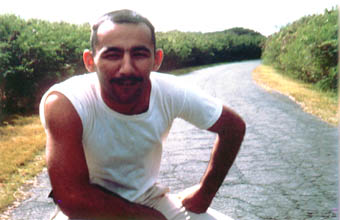
Riding in the pick-up along
perimeter road.
|
We then
drove around the island on the perimeter road and passed
the U. S. Coast Guard station located on the northeast
corner of the island. For some reason, I never did come
and visit these fellow servicemen during my tour -- even
though I had intended to do so on a couple of
occasions.
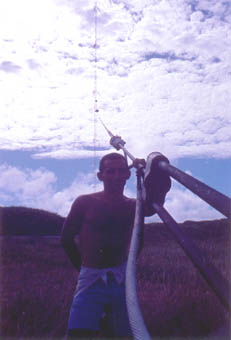
Coast Guard LORAN tower
|
We were
told later that one of fellows there had the duty of
replacing the large bulbs located up the length of the
LORAN tower there which rose about 1,350 feet. We were
also told that he took an 8mm camera with him once and
while strapped to the tower at the top, pivoted around
the tower hanging upside down and filming the island and
surrounding ocean. This was supposed to be a very
dizzying film to watch. I can imagine that it was a bit
dizzying for him!
We also
visited some other sites around the island including the
eastern beaches, which were rocky, and loaded with
vertical walls of rock with in a number of cases, caves
dug into the upper portions of some of these heights.
While
there, I found and collected my first 'beach ball' -- a
ball of varying size made of usually green colored glass
and could range in sizes from about 8 inches to about 24
inches in diameter. These came off of Japanese fishing
nets and washed ashore on a fairly regular
basis.
Heading
towards the interior of the island, and closer to the air
base, we inspected a cargo plane (C-124) which had crash
landed on the island. It was of course but a shell of its
former self, but was fun to explore.
We also
visited a couple of sulfur pits -- which were active
outlets for the volcano and were bubbling mud and hot
water and smelly gases (of course the rotten egg smell).
The smell permeated a good deal of the island and usually
was noticeable until your sensory organs got used to
it.
We visited
the old native village which had been located nearby and
spent a little time there. We were told that the village
folks had been evacuated by the Japanese prior to the
invasion. We were also told -- and am not sure if there
is any fact to this, that because of the rotten egg smell
and fumes around the island, the population was very
small, for women would not stay pregnant -- having
something to do with the fumes. Fact or fiction? Your
guess is as good as mine.
Completing
the island tour, it was now time to begin
work.
Work, for
me consisted of doing weather observations and working a
twelve hour shift and if memory serves me right, I worked
seven days on and then had two off. We were a very small
detachment and probably numbered no more than about five
or six.
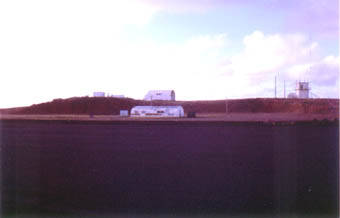
My work area located near
runway
|

Me filling the balloon in the
inflation shelter
|
We mainly
did upper air observations using helium filled balloons
and would release these about twice during a shift. We
filled the balloon to a specified capacity in a building
designed for this purpose and then attached a small
battery operated instrument package. On a prearrange
signal, and coordinated with your coworker in the
tracking room, the balloon and instrument package were
released. You would then have to run over to the tracking
antenna located in a covered facility and manually
orientate the antenna to pick up the signal from the
rapidly rising balloon. If you were not careful, and
especially at night, you could lose the tracking signal
early on and never locate it again -- thus having to
repeat the whole process once more.
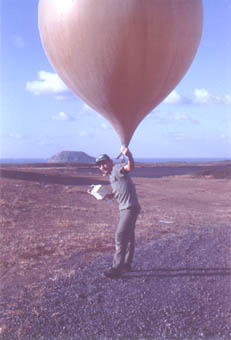
Preparing to make Rawinsonde
release. Interest notation on slide: If I had
some common sense, I would use about 6 of these
balloons and come home -- via air mail.
|
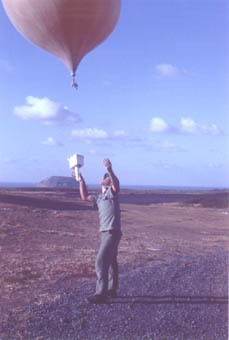
RELEASE!
|
Once the
signal was acquired, we would work as a team taking
readings off of the instrument package and recording them
onto chards, graphs, plotting boards, etc and then coding
the entire finished product into a code which was
transmitted from the base communication facility. The
entire 'run' would take about 4 or 5 hours, until the
balloon -- which expanded as it rose -- burst and the
instrument package fell into the ocean. If this happened
too soon and not enough data was collected (a minimum
requirement was established), then you would have to do
it all over again.
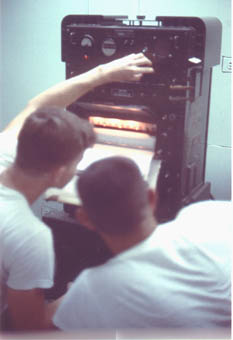
Sgt. Derring &
Nolan
working with the
recorder.
|
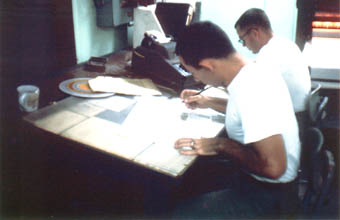
Doing the run's computations and
calculations.
|
After a
while a person would become very proficient in their
duties.
You had a
fair amount of off time on your hands and not a lot to
do.
You could
go to the movies -- usually two or three times a week in
the evening and the all purpose theater was located just
a short work from my barracks on the flight line.
Usually, we would stock up on goodies from the little PX
located between the barracks and the theater and enjoy
one or more movies, depending on what arrived on the C-54
run to the island. Most of the movies were fairly recent
and the choice was pretty much in the blah category (no R
rated type movies for us -- remember, we were isolated
with no women). So this was our big evening on the
island.
Additionally,
there was a small, two alley bowling alley -- which I did
utilize on a few occasions -- but being as the pin setter
was manual, it was more work than it was worth unless you
got a few fellow together -- which rarely
happened.
There was a
small work out room with barbells, etc and this was
visited by myself on one or two occasions. I did not have
much discipline for weight lifting and quickly avoided
this activity.
Another
activity was the swimming pool, located behind the PX. It
was OK and I did spend some time there -- but quickly got
tired of this activity for the water was never changed
and you could not see the bottom of the pool.
Additionally, the water stayed so hot (black concrete!!!)
and it was murky and very warm most of the year. Scratch
another activity.
The
activities for us to keep occupied dwindled rapidly.
One
activity that was enjoyed by all daily was the NCO club.
It was a small club for all to enjoy and there was a
small bar serving, if I recall right, beer and not much
else in the form of liquor. There was a pool table if I
recall and a room to play cards -- very popular among
some of the men. There was also two nickel slot machines
which I took to and spent a number of hours playing when
I had the money. I kept all of my winnings for a 'party
to end all parties' when I came back to the real
world.
Activities
that were first and foremost with most fellows there were
like any other military unit: letter writing!
I had a
girl back home when I left and we wrote to each other a
lot. She had entered nursing school in New Orleans at the
Charity School of Nursing and when she could write -- she
did.
A fairly
new way of communicating was for us to make audio tapes
and exchange these which were nice and a lot more
personal than the letters. However, the letters and
pictures were the predominate form of communication
exchange. The problem was distance and this caused a lot
of confusion. A simple solution was to place a number on
the envelope and keep track of the numbers. This made
things go a little easier and you could at least read the
letters in some semblance of order.
On my long
leave prior to coming to Iwo, I dated my girl, Deanne as
often as I could thinking I would leave in 30 days and we
became pretty close. I had taken a fair number of
photographs of her at her home in North Tipitate (between
Eunice and Basile, Louisiana) and these were my tie to
her. I placed them under a glass top on a desk that I was
able to scrounge for my room. The sight of her smiling in
these images helped to pass the long days and nights
awaiting my year of duty on Iwo.
Of course,
all good things must come to an end.
I got the
inevitable 'Dear John' letter from Deanne about halfway
through my tour of duty and it devastated me. I almost
went insane -- for in her breaking up with me, she
informed me that she had fallen for a med student and was
engaged to marry him upon his graduation! She would even
ask me for brotherly advise!
Long story
short, she and I ended up trading a few nasty barbs via
tape and letter over the next month or so and then
communications between us broke down altogether and I did
not hear from her again until I returned
home.
Because of
our isolation on Iwo Jima, it was arranged that we would
receive R&R every 3 to 4 months -- or so it was on
paper. In my case, because of no one to take my place, I
did not get my trip off the island until I had been there
for NINE long months and I frankly was climbing the walls
by this time.
I was
granted a week leave in Japan and went back via our
trusty C-54 to Tachikawa Air Force Base near
Tokyo.
I spent a
whirlwind week in and around the Tokyo area and even did
a little bar hoppng outside of the base. I even managed
to visit a Japanese bath house, which was a unique
experience.
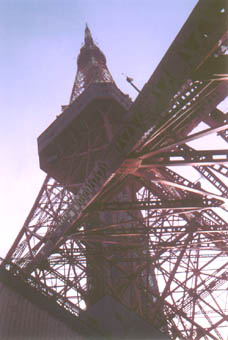
The Tokyo Tower
near
the Imperial Palace.
|
Later, I
visited Tokyo, traveling downtown via commuter train. I
did the tourist thing including the Tokyo Tower, which is
similar in appearance to the Eifle Tower, and other
sights of Tokyo. One thing that still facinates me is a
large department store in Tokyo that I spent time in. It
was almost like being a child in a toy store decorated
for Christmas -- with so many things to catch ones
attention. Even as large as the store was, everything on
display was grouped into small, cramped displays with
every item seeming to scream out at you to buy it.
Bewildering, to say the least.
The
restrooms were wierd with NO toilets -- at least as
Westerners recognize them. There appeared to be what
looked like an oversized urinal placed flat on the tile
floor. It was a little larger than a standard urinal --
but wierd, even so. All was interesting and fun. Even
stranger, this store was in the bustling downtown area of
Tokyo, but a few steps from the Imperial Palace grounds
located nearby.
The week of
course passed fast and before I knew it, it was time to
return back to Iwo.
I repeated
the C-54 flight back to Iwo and went back into my work
routine.
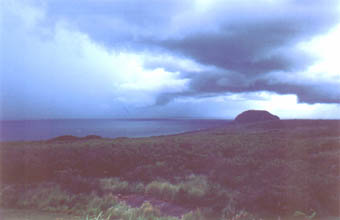
Nasty weather moving over
Iwo.
|
The island
had only a few activities that appealed to me as my time
on the island passed ever so slowly. I got into making
model planes and spending a major amount of time
detailing them and hanging them from the ceiling in my
barracks room which I shared with a fellow by the name of
Willy who I also worked with on my shift. We did as all
of the fellows there did, and placed the centerfold
Playmates from Playboy all over the walls of our room.
With the quonset hut style building, it was neat to see
the lovely ladies literally climbing up the walls and
ceiling.
Another
pastime was tape recording. Almost everyone on the island
bought a reel to reel tape recorder (Sony) and we
recorded everything we could get our hands on including
records, other tapes, etc. We recorded everything...rock
music to classical music -- it did not matter. I built up
a collection of about 50 reel to reel tapes and color
coded them to the type of music. Remember -- I was bored
out of my mind.
The main
activity -- at least where I was concerned -- on the
island, of course, was 'boondocking'. It was our favorite
activity and I went as often as I could -- exploring the
island. I did not really keep in touch with the history
of the battle -- locations of specific landmarks, etc.,
but just went exploring to see what I could find. My
co-worker and friend, Willy went with me most of the
time.
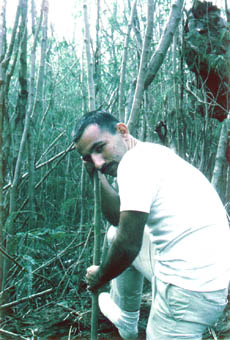
Image of me in the
boonies.
|
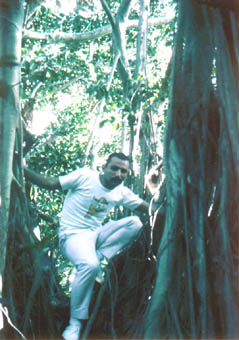
Second image of me in the
boonies.
|
Usually we
would just set out in one direction and cover the terrain
as best we could. At times this was just walking in areas
of grass and very little jungle growth, while other times
we encountered lots of thick jungle growth. At other
times we went to the beach to collect 'beach balls' to
decorate our humble quarters or just to explore the
landscape.
The easiest
location to access was the beach on the eastern side of
the island which was very rocky and had really neat rock
formations and large waves at times hitting the beach. By
leaving our barracks, and traveling along the taxi way to
the end of the runway (basically east and west), this led
to the perimeter road which then led to the area of the
beach. On one occasion, I found a large piece of coral
that had been washed ashore and collected it for my room.
I still have that piece of coral around my house
somewhere -- quite possibly in the attic.
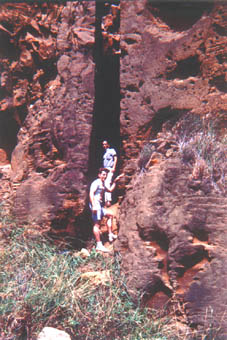
View along rocky beach on
west side of island.
|
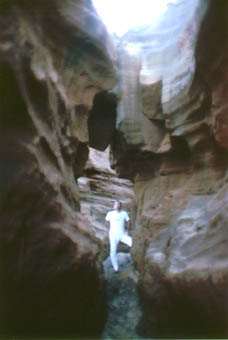
Another view along rocky
beach on west side of
island.
|
On this
beach, there were some fairly sheer rock cliffs that rose
upwards of 50 to 100 feet and were almost non scalable.
On one occasion, a couple of other fellows were with us
and one managed to climb the cliff to a cave located near
the top in order to explore the cave. He was disappointed
to find that the cave only extended some 10 feet or so
into the face of the cliff -- a real letdown considering
the effort of climbing this sheer rock face.
On another
trip, one of the old hands took a group of us in the
interior of the 'jungle' in an effort to show us
'newbees' a fairly untouched machine gun nest. We
traveled through some pretty tough terrain and it rose
and dropped and became heavily entangled in jungle
growth. In fact, it was but about a half mile to a mile
from our barracks -- but through some of the thickest
growth around the island.
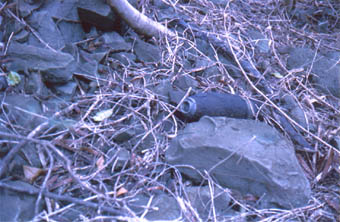
A dud artillery round in the
boonies.
|
We traveled
about an hour and finally came across the machine gun
nest that we were searching for. It was in a sheer rock
formation which rose about 50 feet or so about the mean
level of the area and it was near the bottom of the
formation, and fairly easily accessed if you knew where
to look.
Peering
inside, we were treated to a very interesting sight.
There were some rusting Japanese helmets (about three or
four) along with an equally rusted machine gun base and
stand. The machine gun had long been removed -- but the
bones of the dead defenders were still there -- all
mingled and in disarray -- but there.
We were
told not to handle the bones for it was against the
current military policies in respect for the dead --
whether it be Japanese or American remains. We did look
very closely, but did not touch anything. The trip was
worth it and we felt that we had just experienced a piece
of history. Leaving, we took a somewhat different route
and came across a large outdoor kitchen -- obviously
Japanese and did spend some time here looking over
things. You could see that they had fed many troops with
the size of the kitchen out in the jungle. It was very
large and had locations formed into the concrete cooking
area for large cauldrons for food.
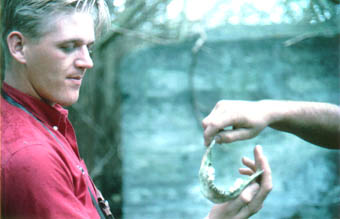
A fellow boondocker holding a
jaw bone
-- Japanese --. It was left were
it was found.
|
One of the
men in the group found and picked up a human jaw bone!
and was promptly told to place it back where he had
picked it up from. He did so but another fellow had his
picture taken holding it before he placed it back in its
location.
Many other
trips were taken around the island and most are but fuzzy
memories only remembered when I view the series of slides
that I took during my stay on Iwo Jima.
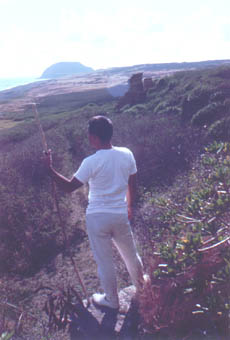
One of the best views of Iwo
Jima
I call this image 'My
Domain'.
|
One such
'boondocking' trek was when Willie and I decided that we
were going to play gung-ho Marines and 'scale Mt.
Suribachi -- on foot'!!! We grabbed our 'cout-stick'
(carved walking sticks that we had made to use while
boondocking) and got a lift to the base of Mt.
Suribachi.
We began
climbing and in no time came to a conclusion that maybe
this was not such a great idea. The sides of the volcano
were very heavily overgrown and the jungle had reclaimed
every square inch with vines, bushes, small trees, grass,
tangles of every kind of imaginable growth one could
consider and we were making very slow progress. We kept
going not knowing if it would be better to head up or
down. We literally were lost and under the thick growth,
it was quite dark. We kept running across large
millipedes which grew on the island to lengths of up to a
foot long. We had been warned to stay clear of these and
we did not need to be reminded.
After what
seemed hours (which in actuality was probably only about
an hour and a half) we started to come into a clearing.
Ahead of us was the winding road which wound around Mt.
Suribachi and we emerged from the jungle growth, filthy,
sweaty, bone tired and exhausted. When we looked around,
we saw that we were only about 1/3 the way up the side of
Mt. Suribachi!
After a
rest, we continued up the side of the volcano -- only
this time by walking up the winding road. It seems that
we had had enough of the game and were only interested in
getting to the top where we could meet our ride back to
the base.
Eventually,
our ride arrived and the two weary 'boondockers' returned
to our fairly comfortable lodging and a couple of beers
at the NCO club.
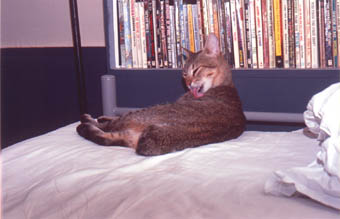
"Cat" [our pet] before he was
killed
[bobbed tailed variety]
|
An
interesting thing about Iwo was that there were a few
cats there -- believe it or not. The breed of cat was a
grey striped tabby with a peculiar difference as compared
to the stateside version. The cats there were short tail
cats -- similar to a bobcat and I believe, brought from
Japan! One of them had befriended the fellow that I had
replaced and he stayed with me a while and eventually --
probably during mating season -- vanished into the jungle
never to be seen or heard from again. I enjoyed his
company while he stuck around.
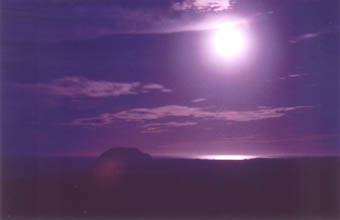
Time lappsed shot of a full
moon
over Mt. Suribachi.
|
During the
late summer nights, the view at night looking at the
night time sky was awesome. Being on an island did have
advantages in that sense. If you wanted to watch the
night sky, this was the perfect vantage spot. During the
late summer, it is especially rewarding for this is the
time of the famous Perseids meteorite shower. A
spectacular show was visible for hours and we had a ring
side seat. After counting literally a couple of hundred
streaks across the brilliant night sky, I gave up the
count and just marveled at Mother Nature's fireworks
spectacular. What a wonderful memory to take back with me
when I went home.
We were
bored there enough to do some silly things on occasion.
On Halloween, I decided to play a trick on the fellows
who usually would sit out in front of their barracks on
cool evenings to watch the crystal clear starry nights.
With no lights to speak of, the stars over Iwo Jima were
some of the most spectacular views of the heavens I have
ever seen. You could almost reach out and touch
them.
On this
particular night I decided to play a Halloween joke on
the other fellows and went to the weather hut located at
the edge of the runway which ran parallel to our barracks
and other buildings on the air base apron.
I took out
a small balloon (used to test wind direction) and
activated a small battery operated light. These were
activated by adding water and slowly the light bulb
attached began to glow. The whole thing was about the
size of a small flashlight and weighed about as much. We
normally used these at night when launching our
radiosonde balloons with a light attached to locate them
while rotating the antenna to began the transfer of
information.
The balloon
was then filled with helium and I tested the weight with
various amounts of helium and eventually got the balloon
to sort of hang over the ground at about a height of 5 to
10 feet with the lighted battery inside. A breeze was
blowing from east to west and I released the balloon and
it slowly glided across the island and eventually out to
sea. It actually never rose above 10 or 15 feet and I was
extatic about 'putting one over the fellows' and
hopefully causing some confusion and even a possible UFO
sighting.
Wrong.
Sneaking back, the fellows were all sitting in front of
their barracks, sucking on beers and jawing away like
usual. One casually mentioned to me that he was surprised
that my instrument release must not have gone too well,
for the damned thing never got very far off of the ground
-- and then they all had a good laugh. Oh well, so much
for my little Halloween prank.

Image F-4 fighter/bomber.
|
One day, we
had an unexpected visitor to the island. The visitor was
an F-4 Phantom which had engine problems and had elected
to use the island as a emergency landing strip.
During the
war, the island was sought after as an emergency landing
strip for B-29's on long bombing missions. Countless
crews were saved when they set down on the island. Prior
to Iwo Jima being taken from the Japanese, the normal
procedure for a damaged plane, was to either make it back
to its home base or to ditch in the ocean -- usually with
loss of some or all of the crew.
Iwo Jima
changed this.
Today,
another plane with engine problems, landed and taxied to
the ramp near my barracks.
Everyone
was all abuzz -- here we had a front line fighter here at
our door step for us to check out. Many a photo was taken
around the plane and I was no exception.
After a few
days, a replacement engine was flown in via C-130. The
engine was replaced and the crew taxied out for take off
with all inhabitants coming out to watch the big
event.
Taking off,
we had hoped for a max power climb out -- with the pilot
electing to take a leisurely climb out to altitude
instead.
This was
the only occurrence of a landing of an unscheduled plane
on the island during my year there. It was quite a
memorable event -- at least for me.
One very
sad occurrence that totally took me off guard was a
letter written by my brother-in-law which arrived. The
letter was written to advise me that my Grandmother had
passed away, following a routine surgical
procedure.
(Text of the
letter)
Milton's Cash Drug
PRESCRIPTION SAVING CENTER
EUNICE, LOUISIANA
Milton Aucoin, B. S. Pharmacy
2.21.66
Dear
Joe
I'm sure
receiving a letter from me comes as a shock. It is good
that it should for I have some sad news to relate to
you.
On Sat.
afternoon the 19th of Feb at about 5. O'clock in the
afternoon your Grandma Hebert Died.
It had
orignally planned that you recieve a telegram informing
you of t' is fact. However since the telegraph office
here was col closed your Uncle Paul was supposed to wire
you from Lafayette but in the general confusion It
slipped his mind.
I Know you
will wonder why some attempt was net made to arrage for
you to get an emer gency leave_ I am the cause of that in
so far as I had been informed on a previous occasion that
Grandmothers were not close kin enough under normal
circumstances to warent one This is more apt to your
present situation with improper transportation
facilities.
Your
grandmother was buried on Sunday afternoon the next day
at 4 P.M and a funeral mass was held this morning at 6.15
A. M, since there were no @@@@@ clergy to say that extra
mass yesterday.
All members
of the family took it reasonably well and I believe you
would be proud of the way your mother stood up to the
situation.
I do net
believe that you were ever fully informed on the nature
of your Grandmother illness. When she became ill a heart
condition know as tachycardiac rapid heart beat in which
the heart is never able to fully relax and continues to
contract and there cause @@@@ the heart to just stop and
do @@@nothing. This however is not what caused her
death_since this is fairly easily to be controlled. An
autopsy after death was performed to determine the exact
casue. I have not seen the report however it was told to
me that it was some type of blood @@@@@@@@ poising that
actually casue death_ Any how Sat at about. 2:30P.M and
operation was deem necessary by the Doctors to attempt to
save her life. They could actually find no organ or
growth that would cause her to be as ill as she was,
hence the necessity of the autospy. The last 2 weeks of
her life she spent in the hospital. She did get her wish
in that the didn't suffer long and did not die alone As
you know since the death of your grandpa she had been
unhappy and I persoanlly feel that she just give up
completely. She was ready and this is borne out by the
fact that the Dr. told me up to the day that she died
that in all honesty he could not tell me what was the
matter cause he did not know. Joe pray for your grand
mother and do not feel to badly because she is really
where she wanted to be. Father Forget says that she is in
a place where we all want to go and she is much happier
now than us @@@ who left here.
love/
Moot
I was
shaken up by this tragic news for my Grandparents had
been very close to me and during my early and later teen
years, had lived with them during my off school months
during the summers of growing up. These periods of time
had been some of the most wonderful times I had ever
spent in my life.
My
Grandfather had died when I was staying there and he had
had a severe stroke and was paralyzed from the neck down
and just wasted away over time. It was very hard to see
him go.
Getting the
tragic news that my Grandmother had just passed away was
like a sledge hammer blow and even to this day, am
troubled by that memory on Iwo so very long
ago.
While on
Iwo, I as mentioned earlier spent many hours
'boondocking' with Willie and sometimes others. One
memorable event was when we spent some time up on Mt.
Suribachi and took quite a few pictures. We even became
very brave and decided to do the no-no....descending into
the crater of Mt. Suribachi! It was interesting and some
of my slides document this little incursion. The view
that day, as most days on the island, was spectacular and
visibility was unlimited.
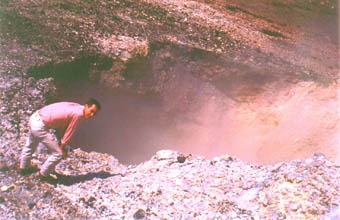
Image of co-worker near pit of
volcano.
|
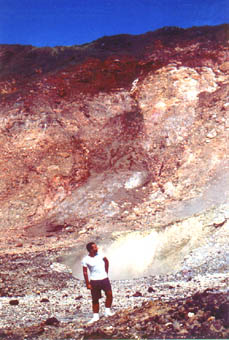
Me near the volcano pit on Mt.
Suribachi
|
On another
day, I ventured up there alone and also had my trusty
camera along as I watched an approaching thunderstorm
build and move directly towards my location atop Mt.
Suribachi. As it neared, I crawled into the small shelter
near the memorial and waited the storm out. Talk about
interesting and and experience for the base of the storm
was actually lower than the top of Mt. Suribachi. Loud
thunder, lightning, heavy rains and jangled nerves are
what I recall. After the storm moved off, I came out of
my little hiding place and continued taking images of the
storm as it moved off to the northeast.
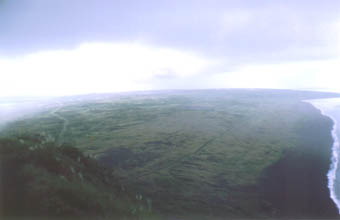
Excellent view of island from
near the flag monument
-- invasion beach is to
right.
|
On the
morning of February 19, 1966, I awoke to the sound of
approaching helicopters and ran outside to see two Marine
choppers approach the ramp. They landed and discoursed a
group of full combat dressed Marines. It seems that a
magazine in Australia had asked for a photo shoot to be
used in an upcoming issue and the Marine detachment was
going to assist in the shoot. This morning, as I recall
was dreary, overcast with a light drizzle periodically
falling and a mist hanging over the island reducing
visibility considerably at times.
I tagged
along, trusty camera in hand and we went to the beach
where the Marines did a rousing blood curdling charge up
from the water's edge while the photographer fired away
with his camera. While on the beach, the Marine unit
formed up and fired off a 21 gun salute on Invasion
Beach. I picked up a couple of the M-1 spent casings and
to this day have one displayed in my office. It is one of
the very few mementos that still remains from my year on
Iwo Jima. After about a half hour of this group of
fellows storming Green-1 Beach, the fun stopped and all
piled into the trucks and headed up to Mt. Suribachi.
Atop Mt.
Suribachi, a fleet of ships appeared off shore of Mt.
Suribachi including the U. S. S. Hornet and its
supporting group of ships. The Marine detachment
proceeded to do a tribute to their fallen comrades and a
small ceremony took place followed by a twenty-one gun
salute.
Then, the
group of Marines managed to produce a flag and long pipe
and proceeded to reenact the famous Joe Rosenthal
photograph. This went on for about 15 minutes with the
photographer taking shot after shot.
Then
everybody headed back and the Marine unit piled into
their choppers and headed out to the fleet off
shore.
All of this
and it is interesting to this day, that I was the ONLY
serviceman who was assigned to duty on the island to
actually take any interest and tag along with the Marine
unit and photographer. No one else seemed to
care!
My year on
Iwo Jima was finally approaching its end. I became short
and when my time came to leave, I was more than ready to
head back to the real world. I packed my personal stuff,
shipped it back home in a large crate and boarded the
trusty C-54 back to Tachikawa for processing
home.
I was there
a few days awaiting my travel orders and did some
shopping for items to bring home to special friends and
family.
I even did
a night on the town and came very close (actually so
close, that when I think of it, it scares the hell out of
me) to being arrested by the Japanese police for
something I had not even done. Luckily, the MP's had
monitored the call and they showed up at almost the same
time extracting me from a possible nasty situation. But,
then that is a different story and one to save when a
bunch of veterans get together and have a few drinks an
tell tall tales.
The next
morning I was on a plane headed home -- reversing the
trip that had brought me to this adventure and a
memorable year in my young life."
2002: In
Retrospect -- Thirty-six years ago, I was a young,
bright-eyed air force enlisted man who spent a year on a
small island in the Pacific Ocean. To be exact --
hollowed ground -- having been bought and paid for by the
lives of over 6,000 young U. S. servicemen and over
20,000 young Japanese servicemen.
Spending
this year on Iwo Jima was at the time, I must admit, not
very historically significant -- at least, in my way of
thinking.
In fact,
the island, to me as well as others there -- was more
like a penal colony. We were isolated.
Period!
We did have
USO shows come and visit us regularly every month or two;
but, these were a shadow of what we considered as the
real world. Here were cute young ladies, and their
dashing escorts, performing silly routines on a small
movie theater stage. They were always escorted by a
contingent of military junior brass. These performances
meant little or nothing to me -- for shortly after they
had finished, they were whisked off to the next stop on
their tour.
Boredom and
loneliness were the two paramount forces at play on Iwo.
You worked, you played, you drank, you tracked through
the boonies to pass time and even so, time stood still --
playing heavily on your mind.
Receiving a
letter from your girl [or at least she WAS your girl when
you left to come to this island, right?], was both
wonderful and at times -- gut wrenching. You saw others
get the dreaded 'Dear John' letter and worried that the
next letter or cassette tape would be the one to tell you
that '....I have found someone else'.
These words
would send your sagging spirits into a major tail spin --
almost never seeming to recover. I felt that I was the
loneliest man in the world then and felt as though I
would never emerge from this pit of depression. It was
not as if you could just head over to the local 'bar and
grill' and hit on another girl. There was no bar and
grill and -- there were no other girls.
So, what
you did on Iwo mainly was to mark time. Mark time until
the day you could say that you were 'SHORT' and headed
home.
You busied
yourself with your work, your past times and trying to
make the best of a lousy assignment. You were thankful
that at least you were not being shot at, like others
that you knew who had gone to Viet Nam.
When you
finally did get the magic carpet ride home on the 707
freedom bird, it was to a different world. Somehow the
world had changed during my year on Iwo Jima. We were
cautioned NOT to wear our uniforms in public upon
returning stateside. We soon found out why. The Viet Nam
war had changed our beloved country and the military was
now hated. Servicemen were taunted, spit on, heckled and
in some cases physically assualted. The plane landing in
San Francisco was greeted by crowds of jeering war
protesters.
So much had
changed in just one short year.
I went into
the military in July 1962, fresh out of high school --
proud to be joining the United States Air Force and
returned four years later, now ashamed of the uniform
that I was wearing.
Surely,
this year on Iwo, though spent on one of America's
historical battlefields, had been but a penal colony to
me.
Joseph L.
Richard
A1C AFC18649096
Det. 12, 20th Weather
Sqd.
United States Air
Force
Note: To
view ADDITIONAL images taken during my
year on Iwo Jima, please click on the following link to
my World War II Stories Photo Album:
WW
II Stories: Iwo Jima Photo Album
1965-1966
Did YOU serve on Iwo Jima?
Did you know that
there is a group of veterans who have gotten together to
form an association of servicemen, no matter what branch
of service, who served at one time or another starting at
the invasion of the island on February 19, 1945 and
continuing until the island was eventually returned to
the Japanese in 1968?
Iwo
Veterans Organization
We, at the
Iwo Jima Memoirs web site wish to offer to
Mr. Joseph L. Richard our most profound THANK YOU for his
poignant story of his personal experiences -- during his
tour of Iwo Jima and especially for allowing us to share
those memories.
Original
story transcribed on 4 November 2002
Story updated
on 27 November 2002
Did YOU serve
on Iwo Jima?
Do YOU
have a story to tell?
Do YOU have a picture or pictures
that tells a story?
Contact me,
Joe Richard and I can help by adding YOUR story to my
site devoted to veterans who served on Iwo
Jima.
If You Would
Like to E-mail us, Click on the Image Below:
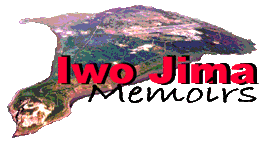
©
Copyright 2001-2007
Iwo Jima Stories
All Rights Reserved
Updated
on 25 October 2007...0913:05 CST
